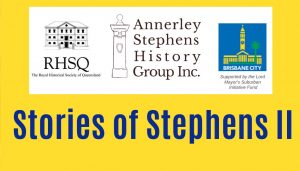In August 2017, the Sydney-based Historic Houses Association of Australia (H.H.A.) conducted its first-ever tour of Brisbane homes. In April, the H.H.A. advertised, through the P.H.A. (Qld) for a Brisbane historian to help organise this tour. Jack Ford successfully submitted an Expression of Interest and he commenced work on this project in May.
The project had two main tasks. The first was the nomination of potential Brisbane homes that could be visited and secondly arranging a tour of these places was the first task. It was to be completed by July. Jack Ford was to provide basic historical information for each site and accompany the H.H.A. members who were on a bus tour near the end of August. The H.H.A. also wanted a list of heritage-listed hotels, within the Brisbane C.B.D. to provide accommodation for the tour group.
Arranging access to homes across Brisbane and its surrounds was not an easy task, as very few ‘Open Houses’ occur here. The H.H.A. wanted to tour two to three residences, per day, during its 3-day tour that was proposed for late-August. Preliminary house tour arrangements could only be made, as the tour could not proceed unless it had sufficient bookings. Final numbers for the tour participants would not be known until the end of July so only then could confirmation of a H.H.A. visit be given to the owners of the various ‘Open Houses’. Another H.H.A. requirement was that any lunch or morning and afternoon tea venues chosen during the tour days, were to be heritage or historical-interest site.
The existing ‘Open Houses’ of ‘Old Government House’, ‘Newstead House’. ‘Miegunyah’, ‘Wolston Farmhouse’ and ‘Ormiston House’ (Redland City) were approached first. Jack was fortunate to have a friend who owned a prominent architect Robin Dods-designed house in Wilston so permission was sought and gained to undertake a tour of that home. These six places had been secured as tour sites, by June, with the Breakfast Creek Hotel, the Mt Coot-tha Lookout Kiosk and the Grand View Hotel (Cleveland) added as dining or refreshments venues. The Manor Apartments (former C.M.L. Building) [built 1930-31], in Queen Street, was chosen by the H.H.A. for the tour’s accommodation. By July, the H.H.A. required at least two more houses for the tour itinerary. Jack had suggested ‘Hanworth House’ in East Brisbane but this had been rejected by the H.H.A., as it was difficult to include in any bus route that incorporated the other ten places. In early July, two more Brisbane houses were added through personal contacts made by a H.H.A. member in Sydney. These were ‘Tarranalma’ at Clayfield and ‘Conon’ at Lutwyche. Thus the H.H.A. was satisfied with both the number and the variety of ‘Open Houses’ that it could advertise for tour bookings.
As with most projects, the tasks required expanded as the work progressed. This required some negotiations between Jack Ford and the H.H.A. over consultancy fees. In July, the H.H.A. had requested that Jack also conduct a heritage walk of the Brisbane C.B.D. on the night before the tour began and then be the guest speaker at the subsequent tour dinner that night. Jack agreed to lead an hour-long C.B.D. tour that took a route from the Manor Apartments, past the G.P.O., across to Post Office Square then through ANZAC Square and across to Central Railway Station before proceeding down Edward Street (past the ‘People’s Palace; the Commonwealth Government Offices and MacArthur Chambers) and back to the Manor Apartments. Jack was unable to be the guest speaker at the tour dinner, as being disabled meant that he faced the prospect of finding a taxi home late at night in the C.B.D. Jack had initially agreed to research and write tour notes that would be provided to the H.H.A. members but then he was asked to produce 22 bound copies of these notes so that they could be distributed throughout the tour bus on the first morning. Both the C.B.D. heritage walk plus the production of the tour notes were undertaken, after the H.H.A. agreed to make extra payments to Jack Ford for this additional work.
After the minimum number of tour bookings was reached, the ‘Open House’ arrangements with home owners were confirmed by Jack Ford on 1 August. The tour schedule was finalised, with the C.B.D. heritage walk set for the evening of Thursday 24 August, with the bus tour planned for Friday 25 August to Sunday 27 August. The last planning task was to decide which places would be incorporated into a bus route for each tour day. The routes taken between the various places were decided upon by Jack Ford and the local bus hire driver.
Advertised by the H.H.A. as its Tropical and Colonial Historic Houses of Brisbane Tour, it was fully booked by 20 H.H.A. members, with H.H.A. Tour Escort Baptiste Cornillier and Jack Ford as Tour Leader. The tour commenced, on 24 August. with a rainy Thursday evening heritage walk around what was once the Brisbane financial district. The bus tour component of the program commenced the next morning, in what was to be the busiest day of the tour, with five homes visited. The day started with a C.B.D. heritage walk along lower Edward Street and through the City Botanical Gardens [1855]. Jack chose this route to compliment the Edward Street route that had been taken on the previous night’s heritage walk. The Friday walk proceeded along the Brisbane River, through the Old Gardens past the former Brisbane Technical College in Q.U.T. and ended with a tour of Old Government House [1860-61]. The bus awaited to collect the 22 participants, near Parliament House, and the next stop was ‘Miegunyah” [1885]. After a morning tea, provided by the Queensland Women’s Historical Association, the house tour proceeded, then the bus stopped at the Breakfast Creek Hotel [1889-90] for lunch. Next it was a tour of ‘Newstead House’ [1846]. The bus parked in Newstead Avenue to allow everyone to have a walk-through Newstead Park, as well. The final stop was at a Robin Dods-designed small house in Hewitt Street, Wilston. This was the former servants’ quarters of ‘Rayham’ [1900], a larger Dods design. A bonus was when the owners of the neighbouring ‘Rayham’ unexpectedly allowed the tour group to see inside their home.
Saturday 26 August was the long-distance bus tour day and so not as many sites could be visited. The bus drove down to Redland Bay, where the tour group had a conducted tour of ‘Ormiston House’ [1862-65] followed by morning tea there. A bonus stop was next as the tour got to see St. Paul’s Anglican Church [1873]. Sadly, the church was not open so a tour inside was unavailable. Then it was a stop at the Cleveland lighthouse [1864] and a walk along Cleveland Point Reserve, before the tour bus stopped at the Grand View Hotel [ for lunch. While there, the proprietor gave an interesting address about the work that had been undertaken to restore the building. The bus took the long journey across to Wacol for a conducted tour of ‘Wolston Farmhouse’. After a revealing walk around the grounds to see the farm’s outbuildings, the group boarded the bus tired but ready for the last stop of the day. The bus crossed the Brisbane River over the Centenary Bridge and drove up to the Mt Coot-tha Lookout and Kiosk [1928]. The group was given the choice of either visiting the viewing platform or buying some, late, afternoon tea from the kiosk. The second full day of the tour had been designed to be a contrast to the first full day. Thus, the group were taken over to the southside and shown rural homes rather than the northside’s suburban homes that were seen on the Friday.
Sunday 27 August was the last day of the tour and it saw a return to Brisbane’s northside. Because of the timing of the tour group’s return flight to Sydney, it was to be a shorter tour day and the final stop needed to be close to Brisbane’s domestic terminal. So only two homes were visited and they were both organised through H.H.A. contacts in Sydney. The bus first stopped at “Conon’ [1863] at Lutwyche. The owners generously supplied morning tea before allowing their visitors to wander around their home. The house had retained some of its original gardens and these were a highlight for many of the tour members. Next the bus took the tour to ‘Tarranalma’ [1890] at Ascot. Much of its grounds had been lost to subsequent urban subdivision development but the owners provided and excellent tour of their two-storey grand residence. This fourth tour day was planned to end with a farewell lunch but the decision on the venue took some time to reach. Jack had suggested a number of old hotels that had Sunday dining such as the Albion Hotel [c1885] and Nundah’s Royal Hotel [1888], as well as two restaurants that were located in pre-1946 buildings and situated along Racecourse Road, Ascot. But the issue became the menus, as none of these had food offerings that were acceptable to the entire tour group. The H.H.A. eventually decided to end its Tropical and Colonial Historic Houses of Brisbane Tour at the ‘150 ASCOT’ restaurant that is located in a modern building. Jack left the tour group after lunch and the bus took them back to their City hotel to collect their baggage and proceed to the airport.
The first foray by the Historic Houses Association of Australia around Brisbane and surrounds was considered to be a great success. Over four days, the 21 members of the H.H.A. were taken by Jack Ford along two heritage walks, enjoyed nine historic homes tours plus visited six other heritage site and were given a running commentary on the history of Brisbane, whenever they were travelling around by bus.

